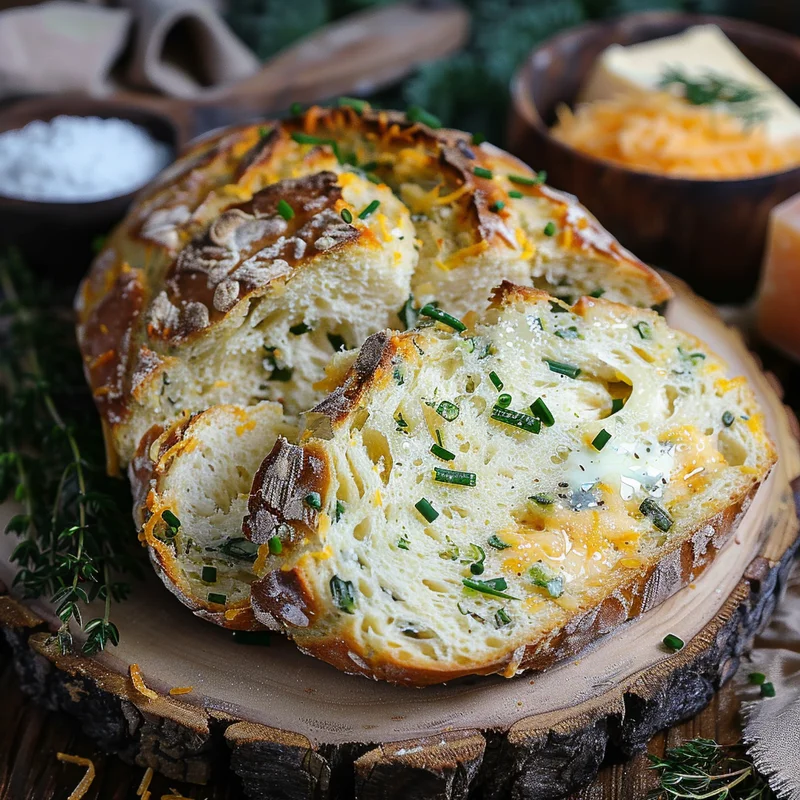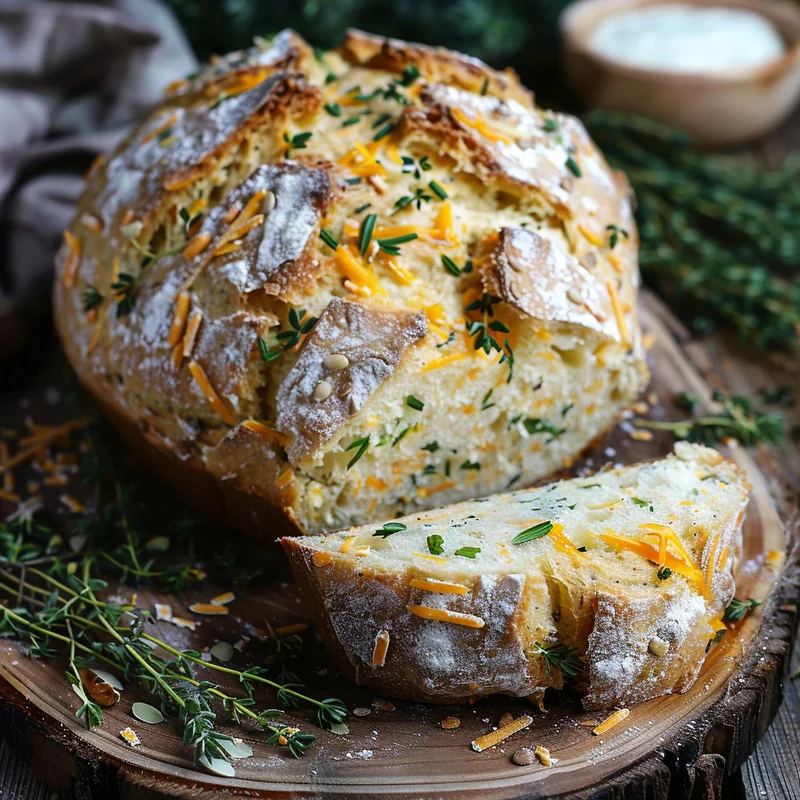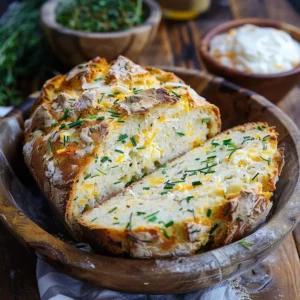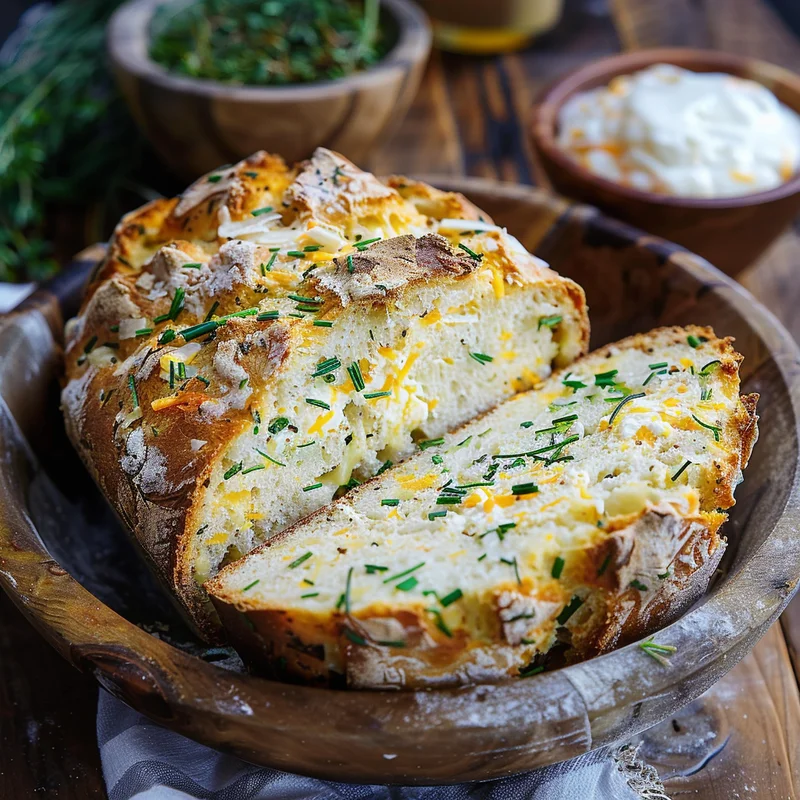Introduction
Oh, you know those days when a craving hits for something warm, comforting, and utterly delicious? Maybe you’re thinking of that bakery bread that always hits the spot, or perhaps you’re just in the mood to create some magic in your kitchen. Well, get ready to meet your new best friend: this Cheddar and Herb Soda Bread. It’s the kind of recipe that feels like a warm hug, impossibly easy to whip up, and destined to become a staple in your home. I remember the first time I made this, and the aroma that filled my kitchen was pure bliss. It’s so quick, you’ll be enjoying a slice (or two!) in no time at all.
Why You’ll Love This Recipe
- Fast: Seriously, from start to finish, this bread is incredibly speedy. Perfect for those last-minute needs or when you just don’t have hours to spare.
- Easy: No fancy techniques or complicated steps here! If you can whisk and mix, you can make this bread. It’s beginner-friendly and totally foolproof.
- Giftable: Imagine gifting a warm, homemade loaf of this goodness to a friend or neighbor. They’ll be so touched (and probably ask for the recipe!).
- Crowd-pleasing: Who can resist cheesy, herby bread? This is a guaranteed hit at any gathering, from casual brunches to cozy dinners.

Ingredients
Gathering your ingredients is half the fun! Here’s what you’ll need to create this delightful loaf:
- 4 cups All-purpose flour: The trusty base for our bread.
- 1 1/2 tsp Baking soda: This is what gives our soda bread its lift, making it wonderfully tender.
- 1 tsp Salt: Essential for bringing out all those wonderful flavors.
- 1 cup Cheddar cheese, grated: Go for a good quality cheddar – it makes all the difference! The sharper, the better, in my opinion.
- 2 tbsp Chives, fresh, chopped: These little green wonders add a subtle oniony bite that’s just delightful.
- 1 tbsp Thyme, fresh, chopped: The earthy, slightly floral notes of thyme pair beautifully with cheddar.
- 1 3/4 cups Buttermilk: This magical ingredient not only adds moisture but also reacts with the baking soda for a light texture. If you don’t have buttermilk, a little trick is to add 1 3/4 tablespoons of white vinegar or lemon juice to regular milk and let it sit for 5 minutes.
How to Make It
Alright, let’s get our hands a little floured and make some bread! It’s so straightforward, you’ll be amazed.
- First things first, let’s get our oven nice and toasty. Preheat it to 425°F (220°C). This hot oven helps our soda bread rise beautifully.
- Grab a big ol’ bowl and whisk together your flour, baking soda, and salt. Give it a good mix so everything is evenly distributed.
- Now, let’s add some flavor! Stir in that lovely grated cheddar cheese, your fresh chopped chives, and the fragrant thyme. Give it another quick stir to get everything cozy.
- Next, make a little well, like a tiny volcano, right in the center of your dry ingredients. Pour in your buttermilk.
- Here’s where the magic happens! Use a fork or a spatula to mix everything together until it just comes together. You’re looking for a shaggy dough – meaning it’s not perfectly smooth, and that’s okay! The key here is do not overmix. Overmixing can make your bread tough, and we want it tender!
- Lightly flour a clean surface and gently turn your dough out. Shape it into a round loaf. Think of it like giving your dough a gentle pat into its final form.
- Place your beautiful round loaf onto a baking sheet that’s lined with parchment paper. If you have a cast-iron skillet, that works beautifully too – just give it a light grease.
- Now for the classic soda bread touch: with a sharp knife, cut a deep cross into the very top of your loaf. This isn’t just for looks; it helps the bread cook evenly.
- Pop it into your preheated oven and bake for 15 minutes at 425°F (220°C).
- After those 15 minutes, it’s time for a temperature adjustment. Reduce your oven temperature to 400°F (200°C) and let it bake for another 20-25 minutes. You’ll know it’s ready when the crust is a gorgeous golden brown and it sounds hollow when you give the bottom a gentle tap.
- Patience, my friends! Let the bread cool on a wire rack for a bit before you slice into it. This allows the inside to set properly.
Substitutions & Additions
This recipe is wonderfully forgiving, and there are so many ways to make it your own!
- Cheese: While cheddar is a star, feel free to experiment! Monterey Jack, a sharp Gruyère, or even a mix of your favorite cheeses would be amazing.
- Herbs: Don’t have chives or thyme? No problem! Fresh parsley, rosemary, or even a pinch of dried oregano can add lovely flavor. A little garlic powder or onion powder could also be a tasty addition.
- Spice: For a little kick, consider adding a pinch of red pepper flakes to the dry ingredients.
- Seeds: A tablespoon or two of poppy seeds or sesame seeds mixed into the dough would add a lovely nutty texture and flavor.

Tips for Success
A few little secrets to ensure your soda bread is absolutely perfect every time:
- Don’t Overwork the Dough: I cannot stress this enough! Mix just until it comes together. A shaggy dough is your friend here.
- Fresh Baking Soda: Make sure your baking soda is fresh! If it’s old, it won’t give your bread the proper lift. You can test it by putting a teaspoon in some hot water; it should fizz vigorously.
- Preheat Properly: A hot oven is crucial for that initial rise.
- Prep Ahead: You can mix the dry ingredients and cheese/herbs the night before and store them in an airtight container. Then, just add the buttermilk and bake when you’re ready!
How to Store It
This bread is best enjoyed fresh, but it stores well for a few days:
Once completely cooled, you can store it at room temperature wrapped tightly in plastic wrap or in an airtight container for up to 2-3 days. For longer storage, you can slice it and freeze it in a freezer-safe bag or container. Just pop a slice in the toaster or microwave to enjoy!
FAQs
Got questions? I’ve got answers!
Q: Why is my soda bread dense?
A: Most often, this is due to overmixing the dough. Remember, mix just until it comes together!
Q: Can I make this recipe gluten-free?
A: While this recipe uses all-purpose flour, you can experiment with a good quality gluten-free all-purpose flour blend that contains xanthan gum. You might need to adjust the liquid slightly, so start with the recommended amount and add a tiny bit more if needed to achieve a shaggy dough.
Q: How long does the cross cut need to be?
A: Aim for a deep cross, about half an inch to an inch deep. This helps heat penetrate to the center of the loaf, ensuring it bakes evenly.
Q: Can I use dried herbs instead of fresh?
A: Absolutely! If using dried herbs, use about 1 teaspoon of dried thyme and 1 tablespoon of dried chives (or a mix of dried parsley/chives). Dried herbs are more potent than fresh.

Cheddar Herb Soda Bread
Equipment
- Large bowl
- Baking Sheet lined with parchment paper
- Cast iron skillet optional, lightly greased
- Sharp knife
- Wire rack
Ingredients
Main ingredients
- 4 cups All-purpose flour
- 1.5 tsp Baking soda
- 1 tsp Salt
- 1 cup Cheddar cheese, grated Sharper, good quality cheddar is recommended.
- 2 tbsp Chives, fresh, chopped
- 1 tbsp Thyme, fresh, chopped
- 1.75 cups Buttermilk Or 1.75 tbsp white vinegar/lemon juice mixed with regular milk and left to sit for 5 mins.
Instructions
- Preheat oven to 425°F (220°C).
- In a large bowl, whisk together flour, baking soda, and salt.4 cups All-purpose flour
- Stir in grated cheddar cheese, chopped chives, and chopped thyme.4 cups All-purpose flour
- Make a well in the center of the dry ingredients and pour in the buttermilk.4 cups All-purpose flour
- Mix with a fork or spatula until just combined and a shaggy dough forms. Do not overmix.
- Gently turn the dough out onto a lightly floured surface and shape into a round loaf.
- Place the loaf on a parchment-lined baking sheet or a greased cast-iron skillet.
- Cut a deep cross into the top of the loaf with a sharp knife.
- Bake for 15 minutes at 425°F (220°C).
- Reduce oven temperature to 400°F (200°C) and bake for another 20-25 minutes, or until golden brown and sounds hollow when tapped.
- Let cool on a wire rack before slicing.

